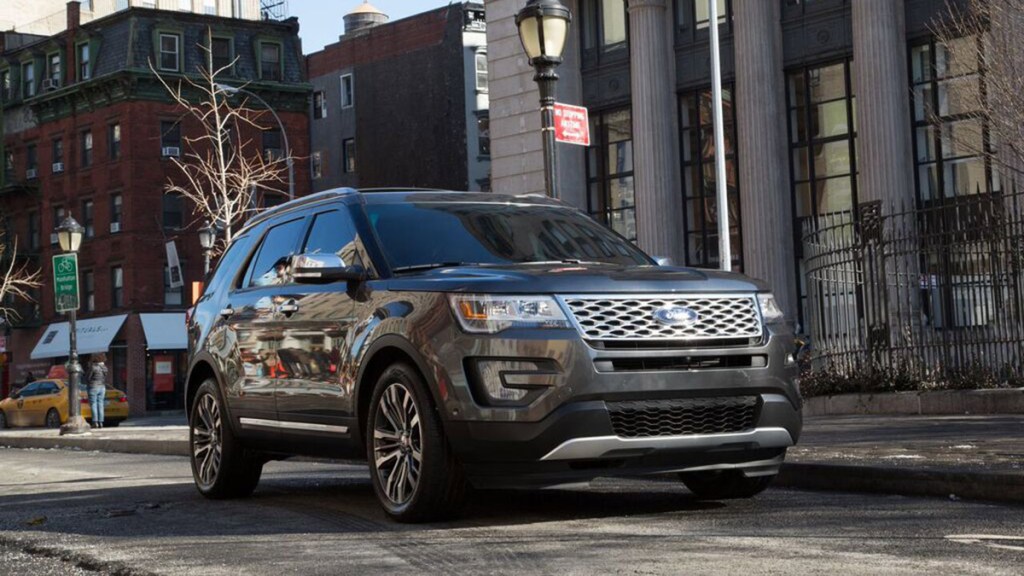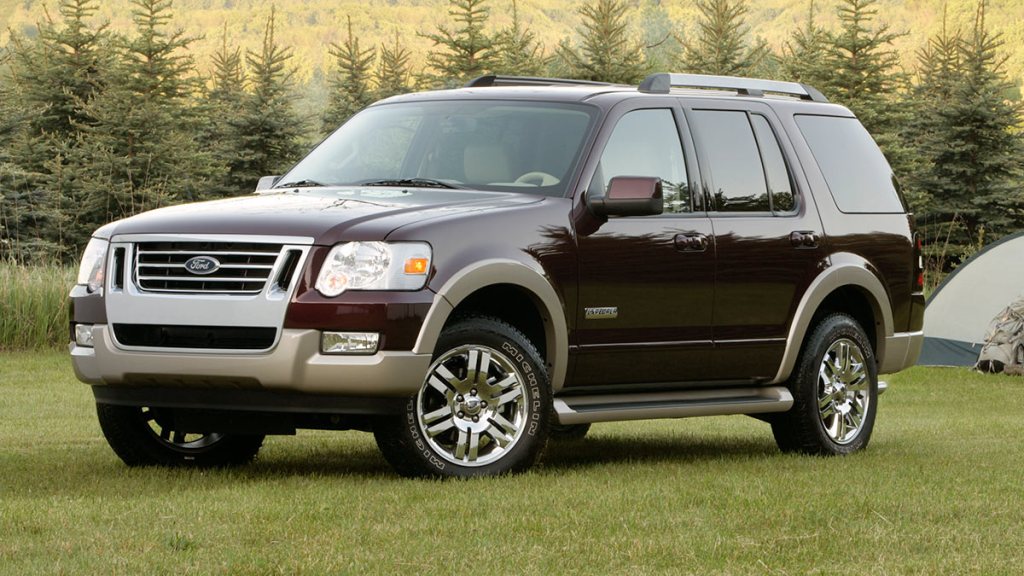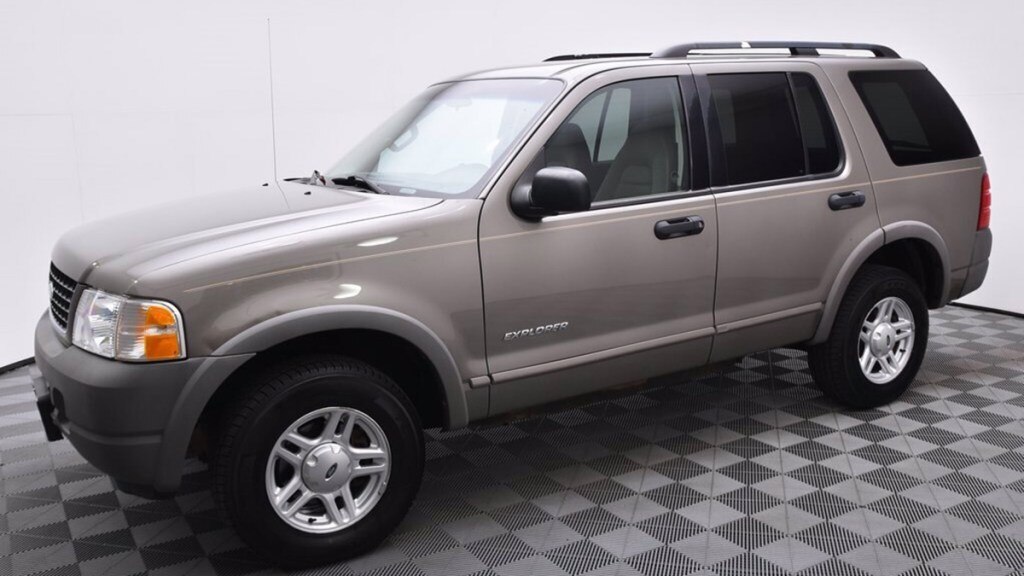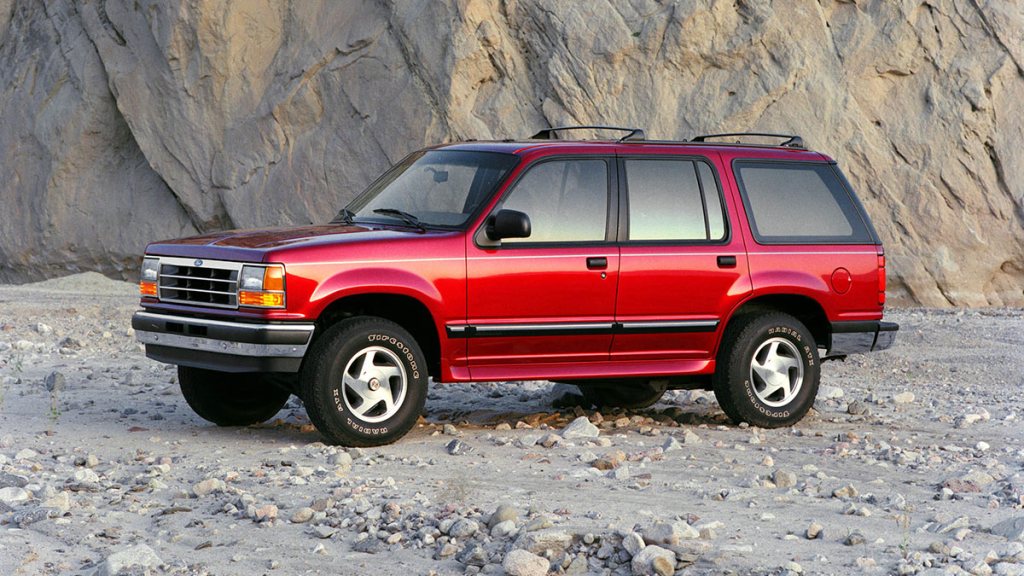Used Ford Explorer Quick Facts
- We recommend buying a used Ford Explorer from the fourth generation, or model years 2006 to 2010, and within the current generation, we single out 2023 Ford Explorers.
- Roughly 35 years and six generations in, the Ford Explorer remains a serious contender in the midsize SUV space.
- When it launched, Ford eyed the 1991 Explorer as a replacement for the Bronco II.
- All Explorer model years, except 2011-2019, featured rear-wheel drive (RWD).
With all the buzz surrounding the current Ford Bronco, it almost seems almost incredulous that Ford engineered the first Explorer on the skeleton of the Bronco II before kicking it to the curb a year or two later. However, Ford certainly didn’t lose sleep over it. Released for the 1991 model year, the upstart Ford Explorer opened the eyes of the masses and was instrumental in creating the SUV frenzy that would descend upon us all. Unlike the Bronco, though, from its inception, the Explorer assumed the role of family hauler but with a more macho approach to filling the core task of the station wagons and minivans of the day.
Roughly 35 years and six generations later, the Explorer remains a serious contender in the midsize SUV competition. The bottom line is, with so many used Explorer SUVs on the road, pinpointing which is best for you is a huge task. Well, we’re here to help by arming you with some used Explorer know-how.
- Best Ford Explorer Model Years
- Which Ford Explorer Is Right for You?
- Ford Explorer Reliability
- Is the Ford Explorer a Good Car?
- Our Favorite Trim Levels
- Our Take: Which Ford Explorer Should You Buy?
Best Ford Explorer Model Years
We recommend buying a used Ford Explorer beginning with the fourth generation, or model years of 2006 to 2010. In particular, we’d single out the 2009 and 2010 editions as among the more reliable earlier model years. Additionally, the fifth generation in general, with models from 2011-2019, is not only more welcoming than previous editions but usually more reliable, too. Within the current generation, we’d single out the 2023 Explorer for our list of recommended model years. We would steer clear of model years before the third generation. Prior to 2003, reliability and owner satisfaction scores were mediocre at best, with recalls often numbering in the teens for the early model years. The recall volume dropped significantly, beginning with the 2003 model.
See used Ford Explorer SUVs near you.
Which Ford Explorer Is Right for You?
Let’s walk through the many model years by generation, beginning with the current one.
Sixth Generation (2020-Present)

With its total redesign for 2020, the 3-row Explorer blasted onto the scene with four drivetrains, including a hybrid. One of those drivetrains, a 400-horsepower twin-turbo V6, was earmarked for the all-new ST performance trim. Resting on a new rear-wheel-drive platform, the Explorer recaptured some of its rugged, tough-job mojo surrendered in the 2011 jump to front-wheel drive (FWD). It boasts one of the most powerful base engines in its class (2.3-liter turbo-4). All-wheel drive (AWD) is optional across the trim level landscape. Larger outside and roomier inside, the Explorer securely retains its family hauling creds. For 2021, Explorer increased the number of hybrid trims and added the new Timberline grade to its lineup. The following year, it added some ST-Line trim variants. The hybrid went away in 2024. Ford then streamlined the bulging trim lineup to just four grades in 2025, as it gave the Explorer a significant buffing up inside and out, as well as some tech upgrades, including Ford Digital Experience and BlueCruise. With the exception of 2025, every model year of this Explorer generation has been listed as a Top Safety Pick or Top Safety Pick+ by the Insurance Institute for Highway Safety (IIHS). (The 2025 anomaly can be attributed to a recent change in IIHS testing protocols.)
What Is the Ford Digital Experience?
A huge jump ahead in driver information, infotainment technology, and presentation, the Ford Digital Experience blends faster processing speeds with higher resolution graphics. These are presented on a 13.2-inch infotainment touchscreen and a 12.3-inch driver-information display. This allows the information and presentation to be customized and saved for each driver and those preset preferences automatically appear. First introduced into the Explorer for 2025, this Google-based system also supports wireless Apple CarPlay/Android Auto. Apps can be downloaded directly from the Google Play store. The Explorer also offers a 5G LTE Wi-Fi hotspot.
What Is Ford BlueCruise?
BlueCruise is an eyes-on-the-road, hands-off-the-wheel, semi-autonomous driver-assist system that is functional on 130,000 miles of designated roads across the United States. In these Hands-Free Blue Zones, the Explorer can steer, brake, and accelerate on its own. Although BlueCruise allows drivers to remove their hands from the steering wheel for extended periods of time, they must stay alert and be prepared to retake control of the driving at a second’s notice.
See 2020 to current Ford Explorer SUVs near you.
Fifth Generation (2011-2019)

Taking a 90-degree pivot, Ford reimagined the Explorer for 2011. All pretense of ruggedness was abandoned in the name of comfort, fuel economy, and approachability. Now, clearly a family hauler of the first order and a bane to minivans, Ford jettisoned the Explorer’s body-on-frame construction, bowing to the ever-increasing popularity of car-based, front-wheel-drive crossovers. Helping to frame the Explorer in this new light was a surge in fuel economy. Where the best government-estimated fuel economy of the 210-hp V6-equipped 2010 Explorer was 16 mpg in mixed city-and-highway driving, the top number with the new 292-hp V6 was 17 mpg. The mileage improved even more with the introduction of an optional 240-hp turbo 4-cylinder delivering 23 mpg in mixed driving for 2012. Ford gave the Explorer a cosmetic makeover in 2016. By 2019, the Explorer boasted an array of advanced safety tech, like automatic forward emergency braking, lane-keeping assist, and more. For model years 2011-2013, the Explorer earned the IIHS designation of Top Safety Pick. Sales surged impressively during this generation.
See 2011 to 2019 Ford Explorer SUVs near you.
Fourth Generation (2006-2010)

Ford retained the base engine and 5-speed automatic transmission. However, once again, Ford upped the optional-engine ante with an even more powerful 292-hp version of its V8 paired with an all-new 6-speed automatic transmission. Suspension tweaks further improved ride quality and handling dynamics. A more integrated face lathered with chrome and a more impressive headlight design led the exterior styling upgrades. Sales took a punch, this time from the ailing economy.
See 2006 to 2010 Ford Explorer SUVs near you.
Third Generation (2002-2005)

Although the Explorer continued into its third generation with its truck-based body-on-frame design, Ford further improved its ride and handling by introducing an independent rear suspension in the 2002 model. The 2-door configuration was relegated to the new Explorer Sport nameplate, leaving Explorer exclusively a 4-door model. The new rear suspension and 4-door-only configuration allowed Ford to add an optional third-row seat. Delivering more power, a new 240-hp V8 joined the carryover V6 base engine as the engine upgrade. Drivers could still stir the transmission themselves in the V6-equipped Explorer; however, beginning in 2003, the only transmission choice was a 5-speed automatic. Not only did Ford further civilize the ride in this generation, but it also refined the Explorer’s styling, giving the Explorer an identity apart from the Ranger pickup. Tempering the enthusiasm for this generation, though, was a notable dip in sales as competition increased.
See 2002 to 2005 Ford Explorer SUVs near you.
Second Generation (1995-2001)

Think of this generation as the coming out of the Explorer. In other words, the distancing of the Explorer from the Ranger pickup and the by-then defunct Bronco with which it still shared many mechanicals. The primary effort was to improve the ride by supplanting the front I-beam suspension with an independent one. Thanks to the overwhelming sales success of the first-gen Explorer, Ford offered up a more powerful 210-hp V8 to supplement the carried-over base engine. Ford also rounded off some of the corners and added a bit of character to the exterior. The Explorer’s footprint was longer, too. Unfortunately, a major dustup in 2000 marred this generation’s reputation over deaths related to tire failure. After a good bit of finger-pointing between the tire maker Firestone and Ford, more than 3 million tires were recalled.
See 1995 to 2001 Ford Explorer SUVs near you.
First Generation (1991-1994)

By today’s standards, the original Explorer was basically a compact. The 2-door version was a bit longer than today’s Jeep Wrangler 2-door. Ford also offered it in a 4-door configuration that was about 10 inches longer. The powerplant was a 155-hp V6 driving the rear wheels through either a 5-speed manual or a 4-speed automatic transmission. Shift-on-the-fly all-wheel drive was optional. Blocky styling highlighted the exterior with rectangular headlights flanking a rather mundane 3-slat grille. It didn’t matter; consumers loved it.
Pro tip: By the way, between 1992 and 1994, Ford built a 2-door Explorer version rebranded as the Mazda Navajo.
See 1991 to 1994 Ford Explorer SUVs near you.
What Is the Ford Explorer Sport?
The Ford Explorer Sport was a renamed continuation of the 2-door Explorer. It was powered by the same 4.0-liter V6 that served as the base engine in the first couple of Explorer generations.
What Is the Ford Explorer Sport Trac?
To expand the Explorer brand, Ford released a crew-cab, short-bed pickup truck under the SUV banner. Skipping 2006, Ford built and marketed the Sport Trac from 2001 through 2010. It is not included in this Explorer retrospective.
Ford Explorer Reliability
Reliability is a key qualifier when shopping for a used Explorer or any used vehicle. However, regardless of the make and model, the older a vehicle is, the more repairs it requires to remain safe and serviceable. With that in mind, let’s take a look at what seems to be the least reliable years for the Explorer.
Ford Explorer Model Years to Avoid
Other than affordability, buying a pre-2003 is a roll of the dice. Reliability and customer satisfaction info is spotty and the annual recalls fairly high. Specific model years we’d avoid include 2004, 2008, 2011, 2016, and 2020 (23 recalls), which all have very low owner-satisfaction scores.
Common Ford Explorer Problems
The most common areas of complaint among early-generation Explorer owners are exterior paint and transmission issues. Specifically, the 5-speed automatic transmission has been a complaint magnet.
Is the Ford Explorer a Good Vehicle?
We’d rate the Explorer about average among used SUVs when considering value, reliability, safety, and utility.
How Much Does a Ford Explorer Cost?
As with any vehicle, Ford Explorer pricing is a product of the model year and trim level. Ford’s resale value history, including depreciation, is about middle-of-the-pack for midsize SUVs. On Autotrader, used Ford Explorers can cost anywhere from a few thousand dollars for older models to upwards of $50,000 for 2025 certified pre-owned models in the Platinum trim, which comes with BlueCruise, a panoramic roof, and heated and ventilated leather seats.
Our Favorite Ford Explorer Trim Levels
Ford Explorer trim levels have come and gone, reaching an all-time high of 10 grades in 2022 and 2023. Here are a few of our favorites and the model years Ford made them available.
- Explorer XLT (1991-2025): Dollar for dollar and pound for pound, we argue the XLT is a perennial value. One step up from the base Explorer, it fleshes out the content, sometimes even adding a degree of luxury. It’s a workhorse suitable for driving the family to dinner or the beach.
- Explorer ST (2020-Present): We can’t help ourselves, as the highest performance Explorer ever, the ST is on our wish list. A 400-hp twin-turbo V6 commands the wheels. It gets a special performance-tuned suspension, too. Leather seating and a digital instrument cluster highlight the cabin.
- Explorer King Ranch (2021-2024): To celebrate two decades of partnership with the iconic Texas King Ranch, Ford added the premium King Ranch grade to the trim lineup. Armed with the same powerful V6 as the ST, the King Ranch forgoes the ST’s other performance upgrades for a Western theme and a healthy dollop of luxury. Special leather upholstery with perforated seat inserts, real wood accents, and King Ranch logos embossed everywhere dress up the cabin.
- Explorer Timberline (2021-2024): The Explorer’s ultimate off-roading specialist, the Timberline was equipped with features like 4-wheel drive, steel skid plates, a Torsen limited-slip differential, off-road tires, revised suspension, increased ground clearance, and hill-descent control.
Our Take: Which Ford Explorer Should You Buy?
You certainly have no shortage of choices. However, we would focus our hunt for a used Explorer within the fifth generation. We like the 2012-2015 models for their style, reliability, comfort, fuel economy, and safety tech. You’ll also find a pretty good value at under $10,000.
See Ford Explorer SUVs near you.











My 2016 had consistent water pump and coolant leaks…absolutely worst car I’ve had.
My 2013 Limited had 208k miles before being totaled after tire exploded and destroyed the rear 1/4 panel. Original water pump.
That yr u recommend had a water pump inside the engine. Repair 3-4 K
Resale to dealer as trade $2K
Sad !